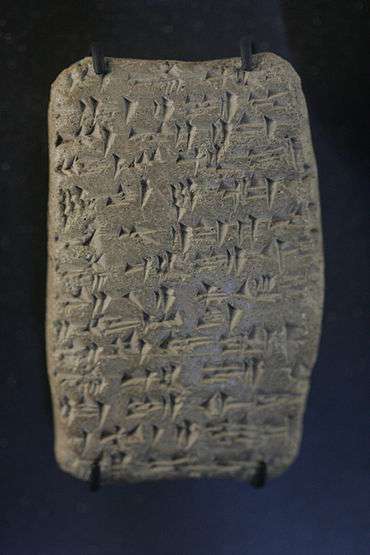Pa (cuneiform)


Usage in Line 8, 4th character; text reads left-to-right.
(very high resolution, expandible photo)
| Wikimedia Commons has media related to Pa (cuneiform). |
The cuneiform pa sign, (as sumerogram, PA), has many uses in both the 14th century BC Amarna letters and the Epic of Gilgamesh. It is routinely and commonly used to spell the Akkadian language word "pānu",[1] face, presence, and with a preposition (ex. ana pānu), before. In the photo of the obverse of EA 364, it is used to spell Akkadian "eperu",[2] 'dust', (EA 364, lines 7,8: "...and (ù dust (IŠ (sumerogram)=dust)) and (u)\ dust "-(a-pa-ru). (The two "and"-s are u-(no. 3), then u-(no. 1)-(u (cuneiform))(the bottom half).)
The alphabetic/syllabic uses and sumerograms of the 'pa' sign from the Epic of Gilgamesh:[3]
- hat
- pa
- PA (sumerogram)s
- SÀG
Its usage numbers from the Epic of Gilgamesh are as follows:[4] hat-(21), pa-(209), PA-(11), SÀG-(1). In the Amarna letters the start of "messenger Xxxxx" is often spelled in cuneiform characters: "LÚ.PA.X.y.z" (etc.), (LÚ the beginning determinative for Man).
References
- ↑ Parpola, 197l. The Standard Babylonian Epic of Gilgamesh, Glossary, pp. 119-145, pānu, p. 135.
- ↑ Parpola, 197l. The Standard Babylonian Epic of Gilgamesh, Glossary, pp. 119-145, eperu, p. 125.
- ↑ Parpola, 197l. The Standard Babylonian Epic of Gilgamesh, Sign List, pp. 155-165, no. 295, p. 159.
- ↑ Parpola, 197l. The Standard Babylonian Epic of Gilgamesh, Sign List, pp. 155-165, no. 295, p. 159.
- Moran, William L. 1987, 1992. The Amarna Letters. Johns Hopkins University Press, 1987, 1992. 393 pages.(softcover, ISBN 0-8018-6715-0)
- Parpola, 197l. The Standard Babylonian Epic of Gilgamesh, Parpola, Simo, Neo-Assyrian Text Corpus Project, c 1997, Tablet I thru Tablet XII, Index of Names, Sign List, and Glossary-(pp. 119–145), 165 pages.
|
|

